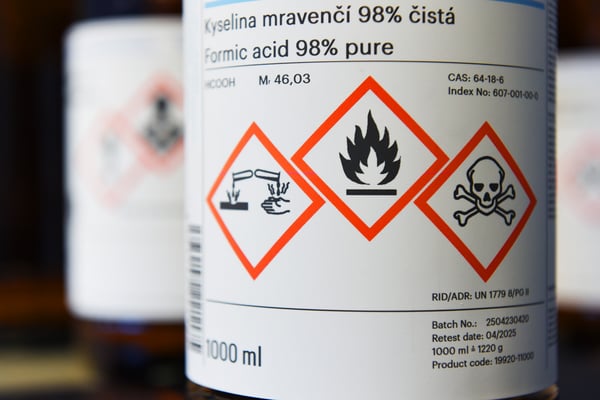Hazardous Materials
What are Hazardous Materials?
Hazardous materials are substances, materials, and products that can pose a risk to human health, safety, and the environment. They can be in solid, liquid, or gas form, and their properties can vary widely, including being flammable, explosive, corrosive, or toxic.
These materials have the potential to harm people, animals, and the environment if not managed appropriately. Hazardous materials are classified based on their properties and potential hazards.
They may be classified as explosives, gases, flammable liquids, flammable solids, oxidizers, toxic or infectious substances, radioactive materials, or corrosive materials.
The classification system helps EHS teams identify and assess the risks associated with hazardous materials and determine the appropriate handling, storage, and transportation requirements.

The Importance of Safely Handling Hazardous Materials
Effective management of hazardous materials is crucial to ensure the safety of workers and the environment.
EHS teams should develop and implement procedures for handling, labelling, storage, and disposal of hazardous materials.
Workers handling such materials need to be trained on the risks associated with the specific material and the appropriate precautions to take.
Hazardous materials should be packaged, labelled, and stored according to their classification and properties. Emergency measures should be in place in case of accidents, including spillage or the release of harmful substances.
Here are a few reasons why managing hazardous materials safely is so important.
Protecting People and the Environment
Hazardous materials can pose serious risks to human health and the environment. Exposure to these materials can result in short- and long-term health problems, including respiratory issues, skin irritation, and cancer.
Certain chemicals can also have adverse effects on wildlife, plants, and entire ecosystems. Proper management of hazardous materials is crucial for protecting people and the environment from these risks.
Compliance with Regulations
The handling and disposal of hazardous materials are regulated by various government agencies, such as the Environmental Protection Agency (EPA) and the Occupational Safety and Health Administration (OSHA).
Businesses that generate or transport hazardous materials must comply with a variety of regulations to ensure that they are being handled safely.
Failure to comply with these regulations can result in significant fines and legal consequences. EHS teams play a key role in ensuring that their organization is meeting all relevant regulations and standards.
Reputation and Public Perception
Companies that have a reputation for mishandling hazardous materials can face significant consequences in terms of their brand image and public trust.
Any negative incidents relating to hazardous materials can do damage to a company's reputation and result in decreased sales and lost opportunities.
By prioritizing hazardous materials management, organizations can demonstrate their commitment to the health and safety of their employees and customers, as well as the environment.
Continuous Improvement and Innovation
By prioritizing hazardous materials management, organizations can also create a culture of continuous improvement and innovation.
EHS teams can work with other departments to identify opportunities to reduce waste, minimize the use of hazardous materials, and find alternative solutions.
These initiatives can not only improve safety and reduce costs but also drive innovation and create new business opportunities.
Reducing the Risk of Accidents and Emergencies
Poor management of hazardous materials can cause accidents and emergencies leading to loss of life and property damage.
In some cases, hazardous materials can pose an immediate threat to the surrounding community when not handled correctly.
Therefore, EHS teams should educate and train employees on how to handle and manage hazardous materials safely to reduce the risk of accidents and emergencies.
Long-Term Savings
Effective management of hazardous materials can also lead to cost savings for businesses. By reducing the amount of hazardous materials generated, organizations can save money on disposal fees and minimize the risk of fines for improper disposal.
Additionally, implementing safety measures can reduce workplace accidents and injuries, resulting in reduced workers' compensation costs and lost productivity.
Promoting Sustainability
Managing hazardous materials is not only about compliance and safety; it also promotes sustainability.
Proper disposal and management of hazardous materials contribute to environmental sustainability by preventing contamination and reducing pollution.
Companies can also explore eco-friendly alternatives to hazardous materials to promote sustainability, reduce carbon footprint, and enhance corporate social responsibility.
Use EcoOnline to Manage Hazardous Materials Effectively
EcoOnline is a comprehensive workplace safety solution that helps companies gain better higher-level performance insights into their overall safety performance.
It allows EHS teams to implement more effective safety decisions and improve the overall adoption rate. EcoOnline supports automations to help companies with better tracking and analyses, reducing overall safety incidents and improving productivity in the workplace.